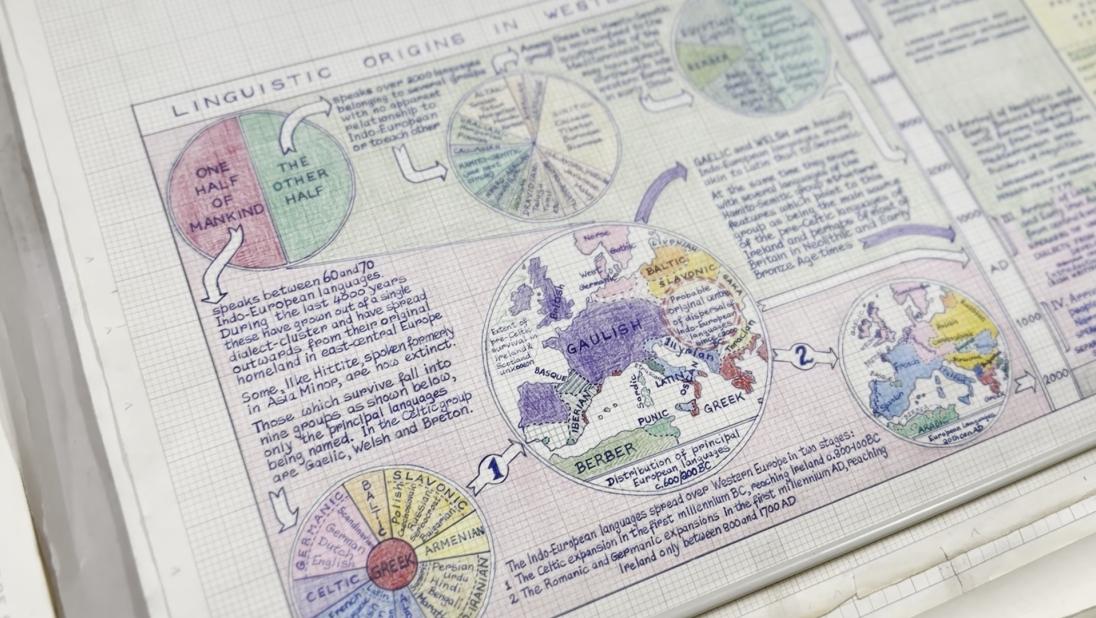
Ulster Dialects At Sixty: A Book, an Archive and a tour so maxty mixty *
* Mixty Maxty: motley, higgledy-piggledy, jumbled and confused
What's this all about?
You may know of the ‘Reawakening’ project for Ulster Folk Museum’s old buildings and landscapes, but did you hear any talk of the museum’s renewed celebration of the spoken word at ‘Ulster Dialects @ 60’, a seminar hosted recently in Cultra Manor?

The event was held to mark the sixtieth birthday of the museum’s very first publication, Ulster Dialects – launched on 1 July 1964, the day before the museum was formally opened.
The seminar was about much more than a book in reprise, however. It pulled together a gaitherin of staff, researchers and aficionados of Hiberno-English, Ulster Scots and Irish who have availed of and appreciated the Ulster Language and Dialect Archive collections at Cultra over the last six decades, to listen to a dozen or so speakers recounting rich anecdotes and happy memories of past words and deeds.
G. B. (Brendan) Adams
As the incumbent Library and Archives Manager for National Museums NI, yours truly had the duty of discussing the genius who was the genesis of the dialect archive, G. B. (Brendan) Adams.

While working in the linen industry, Adams conceived of the idea of an archive of Ulster dialects, and the compilation of a related dictionary. Without ever seeking a university degree, he obtained fluency in 22 languages. He was the driving force who researched, recorded and wrote about regional manners of speech from his office at Cultra Manor for two decades, gaining a global reputation for the Folk Museum’s work in this sphere until his sudden death in 1981.
The work of G.B. Adams
The centrality of Ulster Scots
The lens shifted to the central place of Ulster Scots in the archives. Carol Baraniuk explored the life and work of Prof. Robert J. Gregg, whose papers are held in the Library. Anne Smyth outlined the Folk Museum’s huge contribution to dialectology and lexicography over two generations, including the Concise Ulster Dictionary and her own work at Cultra until 2016.

The dog that ate a dictionary was the unexpected star of the day for a whean of delegates. The pooch wasn’t present, mind. It featured in William Anderson’s excellent exposition of Rev. W. F. Marshall’s pair of handwritten glossaries of mid-Ulster English, which were compiled in the 1940s and for many years were thought lost. Rumour had it that a pet dog had eaten Marshall’s unpublished manuscript. It turned out that the mutt had chewed about 15 pages, but otherwise the text remains essentially intact and a rarely tapped resource.
Hiberno-English
The focus moved onto the Tape-Recorded Survey of Hiberno-English. The ‘three professors’ – Joan Rahilly of Queen’s, Warren Maguire of University of Edinburgh and Karen Corrigan of Newcastle University – rewound the narrative to tell of this landmark accent survey of the 1970s, which is now digitised in the Sound Archive at Cultra; spoke of how it has been used since for phonological research; and fast-forwarded to ‘Speak for Yersel’, a pioneering new accent survey website, another offshoot of the Folk Museum’s legacy.
A very personal touch was added through the panel discussion of TRSHES memories by former interviewers, Dr Tony Lunny and Dr Brendan Gunn, led by Tony’s daughter Sinéad.
The two Fermanagh men hadn’t met each other for over 40 years until early 2024. Yet TRSHES had made indelible imprints on their careers, Tony now being a seasoned barrister, and Brendan a voice coach for Hollywood actors; while Sinéad runs her own firm, Public Speaking NI. Tony and Brendan recalled the unconventional methods they used to win trust and secure recorded interviews as far away as Cork for the 1970s survey; and Tony revealed that he had ambitions of taking over G. B. Adams’ job, but no such vacancy was ever advertised.

We also had the privilege of hearing from Dr Niall Comer and Prof Maxim Fomin of Ulster University, unveiling the new Acmhainn Dhigiteach Uladh website – Ulster Irish Digital Corpus – which was based largely on the 1950s-60s tape-recordings of native Irish speakers, as collected by Rev. Colman Ó hUallacháin and Dr Emrys Evans.
The Mixty Maxty Tour
The seminar decamped to the Folk Museum site for its denouement. The ‘Mixty-Maxty Tour’ was a truncated, rather impromptu and even throughither taster of Rhymin Rab’s Ramble, the Robert Huddleston trail of the site.
This whistle-stop visit to four stops was song-led: with aplomb, Grainne Milner McLoone sang Huddleston-composed lyrics that had not been aired in perhaps 150 years, if ever – namely, ‘The Poor Downtrodden Farmer’, ‘The Canty Tailor’ and ‘Joanie Bates’. Dr Frank Ferguson (UU) stepped up with his own rendition of a Huddleston song at McCusker’s Pub, where Grainne sang us out with ‘The Parting Glass’.
Blessed with autumnal sunshine, the departing attendees declared the event enlightening, entertaining and maybe even a wee bit ecumenical. Through reconnecting with its roots in this aspect of intangible heritage, Ulster Folk Museum moved closer to realising its unique potential as a research hub, discussion forum and positive platform for the native tongues of this province, which have been too often thrown up against one another like rutting deer in headlong conflict.
Listen out for more ‘Languages of Ulster’ initiatives at the Folk Museum in the months ahead, if not indeed for the next 60 years.
Explore more of the Ulster Dialect Archive
A Year in Words: The Ulster Language and Dialect Archive
Project Archivist Niamh Dolan writes about 'Unlocking Ulster’s Languages Archives’, a National Museums NI project.
Rhymin Rab’s Ramble
An educational, self-guided tour exploring the story of the Ulster Scots language with 'Bard of Moneyrea', Robert Huddleston
Cúl Trá-il
An educational, self-guided tour of the museum exploring the story of the Irish language through the places and people of Ulster Folk Museum








